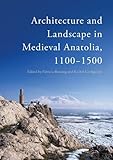Architecture and Landscape in Medieval Anatolia, 1100-1500 / Patricia Blessing, Rachel Goshgarian.
Material type: TextPublisher: Edinburgh : Edinburgh University Press, [2022]Copyright date: ©2017Description: 1 online resource (312 p.) : 64 B/W illustrations 16 colour illustrationsContent type:
TextPublisher: Edinburgh : Edinburgh University Press, [2022]Copyright date: ©2017Description: 1 online resource (312 p.) : 64 B/W illustrations 16 colour illustrationsContent type: - 9781474411295
- 9781474411301
- 720.9561 23
- NA1363 .A73 2017eb
- online - DeGruyter
- Issued also in print.
| Item type | Current library | Call number | URL | Status | Notes | Barcode | |
|---|---|---|---|---|---|---|---|
 eBook
eBook
|
Biblioteca "Angelicum" Pont. Univ. S.Tommaso d'Aquino Nuvola online | online - DeGruyter (Browse shelf(Opens below)) | Online access | Not for loan (Accesso limitato) | Accesso per gli utenti autorizzati / Access for authorized users | (dgr)9781474411301 |
Frontmatter -- Contents -- List of Illustrations and Tables -- Acknowledgements -- Foreword -- 1 Introduction - Space and Place: Applications to Medieval Anatolia -- Part I Building: Masons and Infrastructure -- 2 Craftsmen in Medieval Anatolia: Methods and Mobility -- 3 Stones for Travellers: Notes on the Masonry of Seljuk Road Caravanserais -- Part II Social Groups: Akhis and Futuwwa -- 4 Suggestions on the Social Meaning, Structure and Functions of Akhi Communities and their Hospices in Medieval Anatolia -- 5 Social Graces and Urban Spaces: Brotherhood and the Ambiguities of Masculinity and Religious Practice in Late Medieval Anatolia -- Part III Exchange: Islamic and Christian Architecture -- 6 Transformation of the 'Sacred' Image of a Byzantine Cappadocian Settlement -- 7 The 'Islamicness' of Some Decorative Patterns in the Church of Tigran Honents in Ani -- Part IV Frameworks: Language, Geography and Identity -- 8 Harvesting Garden Semantics in Late Medieval Anatolia -- 9 All Quiet on the Eastern Frontier? The Contemporaries of Early Ottoman Architecture in Eastern Anatolia -- 10 The 'Dual Identity' of Mahperi Khatun: Piety, Patronage and Marriage across Frontiers in Seljuk Anatolia -- Notes on Contributors -- Bibliography -- Index
restricted access online access with authorization star
http://purl.org/coar/access_right/c_16ec
Assesses and analyses medieval Anatolia from the perspectives of architecture, landscape and urban spaceAnatolia was home to a large number of polities in the medieval period. Given its location at the geographical and chronological juncture between Byzantines and the Ottomans, its story tends to be read through the Seljuk experience. This obscures the multiple experiences and spaces of Anatolia under the Byzantine empire, Turko-Muslim dynasties contemporary to the Seljuks, the Mongol Ilkhanids, and the various beyliks of eastern and western Anatolia.This book looks beyond political structures and towards a reconsideration of the interactions between the rural and the urban; an analysis of the relationships between architecture, culture and power; and an examination of the region's multiple geographies. In order to expand historiographical perspectives it draws on a wide variety of sources (architectural, artistic, documentary and literary), including texts composed in several languages (Arabic, Armenian, Byzantine Greek, Persian and Turkish). Original in its coverage of this period from the perspective of multiple polities, religions and languages, this volume is also the first to truly embrace the cultural complexity that was inherent in the reality of daily life in medieval Anatolia and surrounding regions.Key FeaturesIncludes 10 case studies of architecture, urban space and landscape in medieval AnatoliaReflects current trends in scholarship on this complex frontier zone, showing the fluid frontier character of the region to be crucial for its building fabricExplores themes such as the persistence of Christian settlements and communities, the impact of Mongol invasion, the role of Sufi communities, and the definition of landscapes in textsShows how spaces and places were created and understood by people living in Anatolia from the 12th through to the early 16th centuriesContributorsMattia Guidetti, University of ViennaRichard McClary, University of EdinburghFatma Gül Öztürk, Çankaya University, Ankaraİklil Selçuk, Özyeğin University, IstanbulCinzia Tavernari, Aptullah Gül University, KayseriNicolas Trépanier, University of MississippiSuzan Yalman, Koç University, Istanbul
Issued also in print.
Mode of access: Internet via World Wide Web.
In English.
Description based on online resource; title from PDF title page (publisher's Web site, viewed 02. Mrz 2022)


